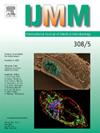Genomic analyses of enteroinvasive Escherichia coli revealed the circulation of conjugative virulence plasmids and emergence of novel clones
IF 3.6
3区 医学
Q1 MICROBIOLOGY
引用次数: 0
Abstract
Enteroinvasive Escherichia coli (EIEC) is a diarrhoeagenic E. coli pathotype that shares key virulence traits with Shigella, including the invasion plasmid (pINV). In Thailand, an outbreak caused by the EIEC serotype O8:H19—the first reported in the country—occurred in 2023, affecting over 150 patients. To elucidate the emergence, clinical relevance, and epidemiological distribution of EIEC in Thailand, we conducted a comprehensive investigation. We isolated and genomically characterised 63 isolates, comprising 28 EIEC (eight serotypes, including O96:H19 from a 2024 outbreak) and 35 Shigella (25 S. sonnei and 10 S. flexneri), along with 85 global reference strains. Comparative genomics revealed that the 2023 and 2024 EIEC outbreak isolates, along with a novel OX18:H25 EIEC lineage, harboured highly similar pINV plasmids with conserved invasion genes and complete conjugation elements. These isolates retained several biochemical traits that were more typical of commensal E. coli than classical EIEC. Limited chromosomal genome reduction—a hallmark of Shigella— was observed, which suggests that these lineages are in an early stage of adaptation toward a pathogenic lifestyle. Phylogenomic analysis showed that OX18:H25 is closely related to livestock-associated E. coli, supporting the hypothesis that pINV was recently acquired via horizontal gene transfer. These findings highlight the active circulation of putatively conjugative virulence plasmids among E. coli populations and the ongoing emergence of novel EIEC clones with epidemic-inducing potential.
肠道侵入性大肠杆菌的基因组分析揭示了共轭毒力质粒的循环和新克隆的出现
肠侵入性大肠杆菌(EIEC)是一种腹泻致病性大肠杆菌,与志贺氏菌(Shigella)具有相同的关键毒力特征,包括入侵质粒(pINV)。在泰国,由EIEC血清型O8: h19引起的疫情于2023年发生,影响了150多名患者,这是该国首次报告的疫情。为了阐明EIEC在泰国的出现、临床相关性和流行病学分布,我们进行了全面的调查。我们分离并鉴定了63株分离株,包括28株EIEC(8种血清型,包括来自2024年暴发的O96:H19)和35株志贺氏菌(25株sonnei和10株flexneri),以及85株全球参考菌株。比较基因组学显示,2023年和2024年爆发的EIEC分离株,以及新的OX18:H25 EIEC谱系,具有高度相似的pINV质粒,具有保守的入侵基因和完整的偶联元件。这些分离株保留了比经典EIEC更典型的共生大肠杆菌的几种生化特性。有限的染色体基因组减少——志贺氏菌的一个标志——被观察到,这表明这些谱系处于适应致病性生活方式的早期阶段。系统基因组分析显示,OX18:H25与家畜相关的大肠杆菌密切相关,支持了pINV是最近通过水平基因转移获得的假设。这些发现强调了假定的共轭毒力质粒在大肠杆菌群体中的活跃循环,以及具有诱导流行潜力的新型EIEC克隆的不断出现。
本文章由计算机程序翻译,如有差异,请以英文原文为准。
求助全文
约1分钟内获得全文
求助全文
来源期刊
CiteScore
9.70
自引率
0.00%
发文量
18
审稿时长
45 days
期刊介绍:
Pathogen genome sequencing projects have provided a wealth of data that need to be set in context to pathogenicity and the outcome of infections. In addition, the interplay between a pathogen and its host cell has become increasingly important to understand and interfere with diseases caused by microbial pathogens. IJMM meets these needs by focussing on genome and proteome analyses, studies dealing with the molecular mechanisms of pathogenicity and the evolution of pathogenic agents, the interactions between pathogens and host cells ("cellular microbiology"), and molecular epidemiology. To help the reader keeping up with the rapidly evolving new findings in the field of medical microbiology, IJMM publishes original articles, case studies and topical, state-of-the-art mini-reviews in a well balanced fashion. All articles are strictly peer-reviewed. Important topics are reinforced by 2 special issues per year dedicated to a particular theme. Finally, at irregular intervals, current opinions on recent or future developments in medical microbiology are presented in an editorial section.

 求助内容:
求助内容: 应助结果提醒方式:
应助结果提醒方式:


